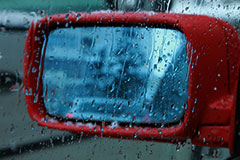Preventing Foggy Windows - Vol.343
When driving in cold weather, there is a chance to have your vision obscured due to accumulated moisture fogging up your windows.
A common problem, the occurrence of a foggy windshield is because of the contrast of warm and cold temperatures from outside and that of within the vehicle. Upon the warm air touching the cold surface of cooled glass, the moisture condenses. And, if its temperature fall's below the dew point, water vapor trapped within the vehicle will then condense and turn into liquid dew, which then results in the aforementioned issue. During warm weather, a foggy windshield is a result of the opposite effect, where warm, humid air from the outside hits the cold surface of a windshield cooled by the car's air conditioning system.

Why does this happen? In cold weather, the simple act of heating up your car, sweating, or even the buildup of moisture from your breath can cause a foggy windshield. While it may be a nuisance, a foggy windshield can potentially be hazardous due to it obstructing your vision while driving. With distracted driving being the leading cause of auto-related accidents and deaths, it is an issue easily prevented that can potentially save your life.
While newer cars from certain manufacturers come with an automatic climate control system that are equipped with humidity sensors that can assist with the prevention of fogging, it's important to know other methods to deter or minimize the effect of a foggy windshield, such as:
- Ensure proper ventilation after heating up your vehicle. Trapped moisture inside the car can easily be fixed by opening your windows even slightly so the temperature inside better matches that of the outside ambient temperature. Note that it's better to use fresh air instead of your vehicle's air recirculation mode as the latter recycles the moist air already trapped within the car. (Note: for hot weather, to have your interior air better match the temperature and humidity of the outside
- If the outside air is too cold, another method is to activate your front and rear defrosters while blowing warm air on the surface of your window to evaporate the accumulated dew and fog caused by condensation. It's key to have a constant dry air circulating inside your car in order to prevent condensation.
- There are window treatments that can help with the prevention of foggy windows. Rain-X Anti-fog is one example of a product that you can use, though its effectiveness may vary depending on how clean your windows are. It is important to have your windows spotless prior to applying the product; use only a small amount and apply a small layer over the glass and buff it immediately. When applied improperly, the product can likely worsen the outcome and is very hard to remove.
- Keeping your windows clean doesn't just help with window treatment. Dirt, dust, and winter grime can accumulate on your wind shield, which can impair your vision?having fog on your windshield can further exacerbate the situation.
- Keep a supply of dry washcloths on hand to wipe away dew and fog. Purchasing a pack of white washcloths are cheap and easy to obtain at your local store. Buying purpose-specific cotton window towels are a good investment as they are lint-free and highly absorbent. However, be sure to have separate towels for your car's interior and exterior.
- Get a maintenance check up to see if your car's windows and doors' seals are intact. Having torn rubber stripping can be a significant factor in how water can enter your vehicle.
- Consider investing in a dehumidifier to remove moisture within your car.
- For those of the frugal mind, there are various DIY methods to deter and help prevent window fogging?such as cat litter-filled socks, using plain bar soap?though we cannot ensure their effectiveness.